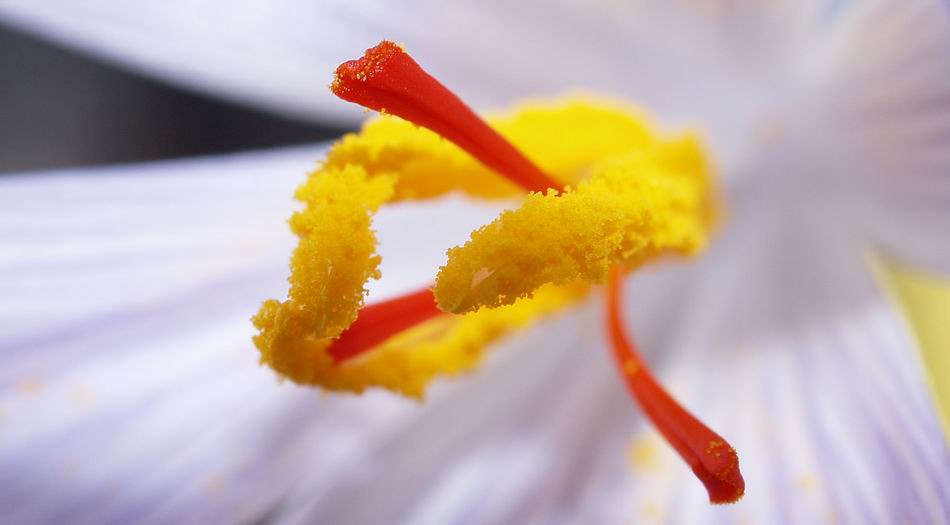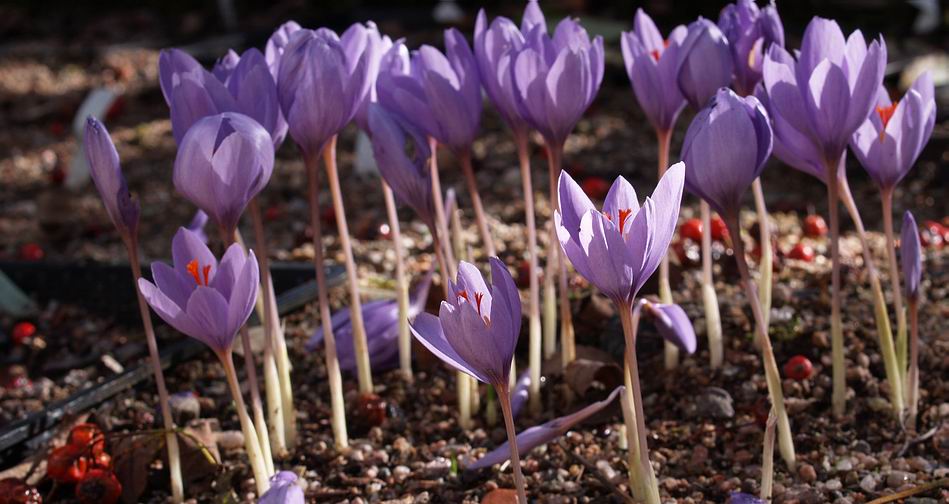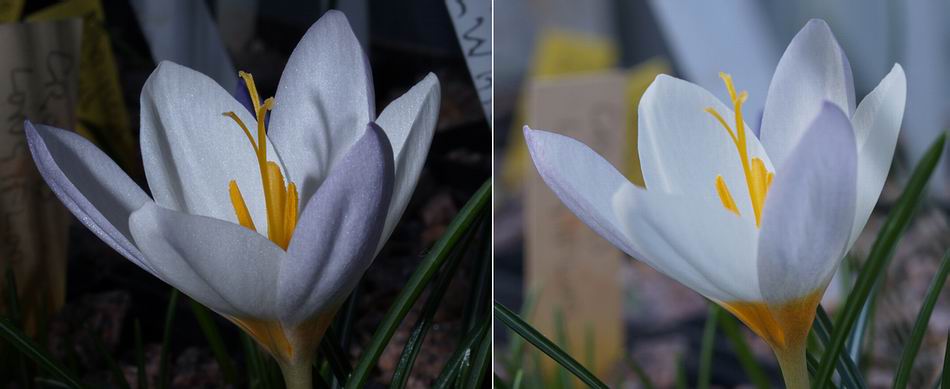|
BULB LOG 43 --- 21st October 08

Pollinator on crocus
Thank you for all the compliments on some of my macro photographs in last week's bulb log. I mostly prefer to have my camera on a tripod but insects are not always willing to wait until you get into position and, if they do, they have an annoying habit of flying off just before you push the button -so when I am photographing insects I am usually hand-holding the camera. I am using an Olympus digital SLR with a macro lens attached and even in bright sunlight I use the small built in flash unit to boost the daylight which allows me to keep a fairly small aperture and hence a good depth of field - the flash also helps freeze any slight movement of the camera or the subject.

Pollen on crocus pallasii with flash
I often employ the flash when taking extreme macro pictures as it does mean that you can get a much more detailed picture with more sharpness.

Pollen on crocus pallasii
Here is basically the same shot this time taken without the use of the flash and I think you can clearly see the difference. Both pictures have their uses; it depends what you want the image to say. The sharper one taken with the aid of the flash gives much more detail while the one without flash is more artistic with the sharpness on the top of the stigma and anthers contrasting with the blurry background.

Crocus medius
Not all the Crocus action is happening under glass - this group of Crocus medius is growing outside in one of the sand plunges. Unfortunately these have to take their chances with the wind and rain that we so often get at this time of year but when the sun does shine it is lovely to see the crocuses in the open garden.

Crocus speciosus 'Oxononian'
We have a number of corms of Crocus speciosus growing outside like this 'Oxononian' which is growing in a trough.

Crocus speciosus
This is a very dark form that we got from Alastair McKelvie a number of years ago. It is about as dark a form as I have ever seen and I am sure that it has probably got a cultivar name but I do not know it. I also used fill-in flash to capture this picture as the flower was in deep shade and the wind was shaking it around good-oh. While I am a big exponent of the tripod I do understand its limitations and I have often been amused in the past, both in gardens and out in the hills, when I see a dedicated photographer setting up his tripod to get a really sharp image of a plant not realising that while his camera may be rock steady the plant is thrashing around in the wind - they would be much better employing a flash in those conditions.

Crocus pulchellus and speciosus hybrid
Back in the shelter of the bulb houses two closely related species flower side by side. On the left is Crocus pulchellus and on the right is a seed raised C.speciosus ssp. xantholaimos - well it is supposed to be. I raised it from my own seeds and obviously, as the sharp eyed croconuts will have already spotted, from the white pollen they have hybridised.

Crocus speciosus x pulchellus
I have a number of pots of seedlings of C.speciosus ssp. xantholaimos from my own seed and there are many similar hybrids in among them.

Crocus pulchellus albus
The beautiful elegant flowers of Crocus pulchellus albus - just disappearing to the right is C.speciosus ssp. xantholaimos with yellow pollen.

Crocus pulchellus albus x speciosus
So often we see this larger less graceful form of Crocus pulchellus albus offered in the trade but I suspect that it has also crossed with C. speciosus - it is still a very desirable plant.

Crocus pulchellus and kotschyanus kotschyanus
I often show these two very similar flowers together even though they are not that closely related. Crocus pulchellus (left) and C. kotschyanus kotschyanus both have white pollen and similar coloured floral segments with yellow throats with the exception that the yellow forms distinct 'w' shapes in kotschyanus formerly called C. zonatus.

Crocus pulchellus and kotschyanus
I have a strange pot of Crocus which is labelled C. biflorus isauricus but I must have let seed drop into it as not only have I the spring flowering biflorus but also these lovely autumnal ones as well. Even they are not all the same species as the taller one is Crocus pulchellus and the rest of them are all C. kotschyanus - quite a mixture that shows how easy it is to get mixed pots when crocuses are seeding around in the pots.

Crocus kotschyanus
This is one of my main pots of Crocus kotschyanus which was raised from seed ex the collection CMW 2685 - so not first generation. It is important when we move through the generations of bulbs raised from collected material that we record it as 'ex' because as I have shown above it can very easily get mixed or hybridise in subsequent generations.

Crocus asumaniae
Notice how the crystalline sparkle that you get on many flowers is clearly seen on this photograph of Crocus asumaniae - again I have used the small built-in flash to capture this.

Crocus asumaniae x2
Here is the illustration of the two effects - the picture on the left is in natural light while I used fill-in flash for the right hand shot. Again there are advantages to both shots and as a photographer it is important that you learn and understand all the effects possible so that you can get the best results from your efforts.

Croucuds caspius x2
Once more with Crocus cyprius the left hand picture employs flash while the right hand one is in natural daylight. There is no doubt that in this case that bit of fill-in flash has brought out the true colours much better than the natural light shot has but this is not always the case so there is a good argument to always try both methods.

Crocus montage
I will finish off this week by letting the Crocuses speak for themselves - what more could I add?
^ back to the top ^
|

